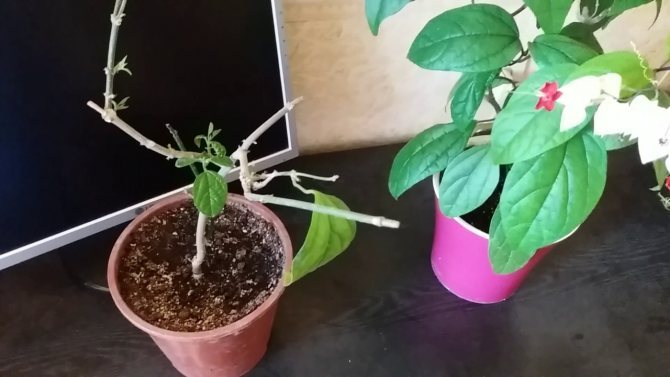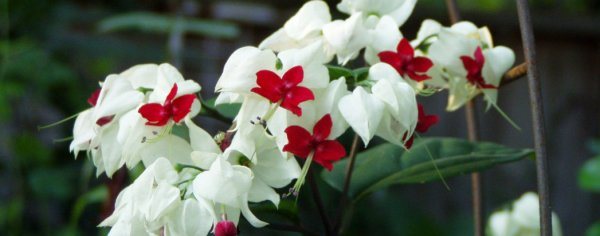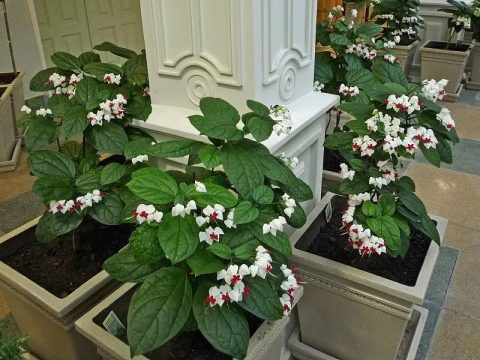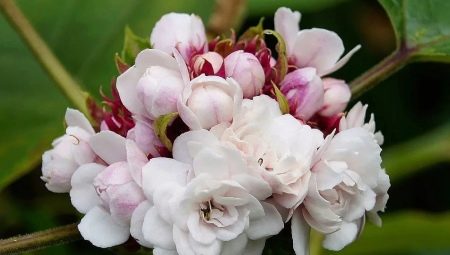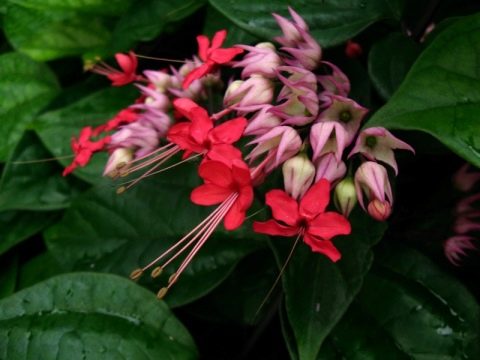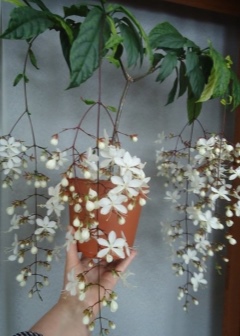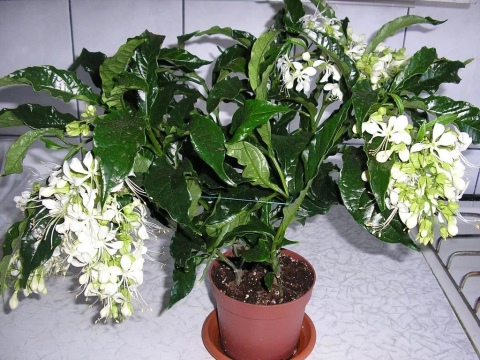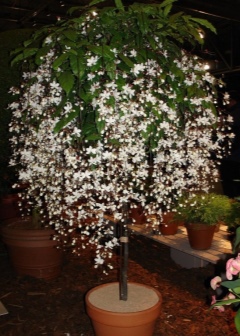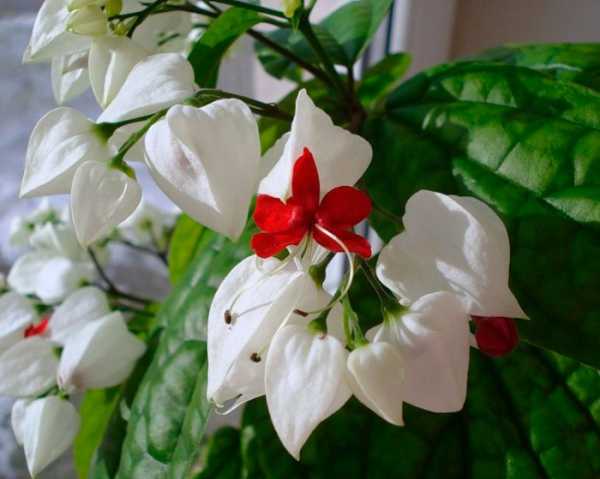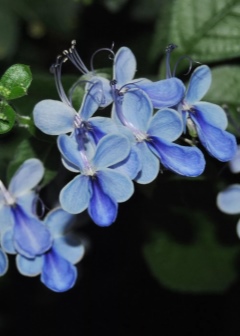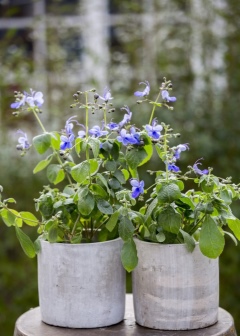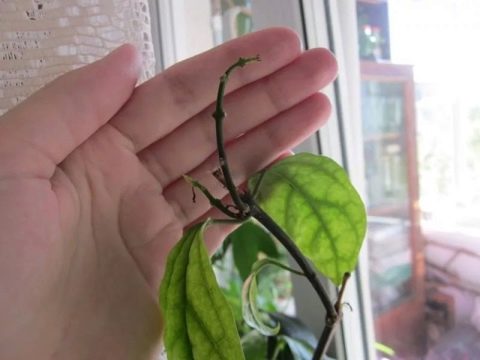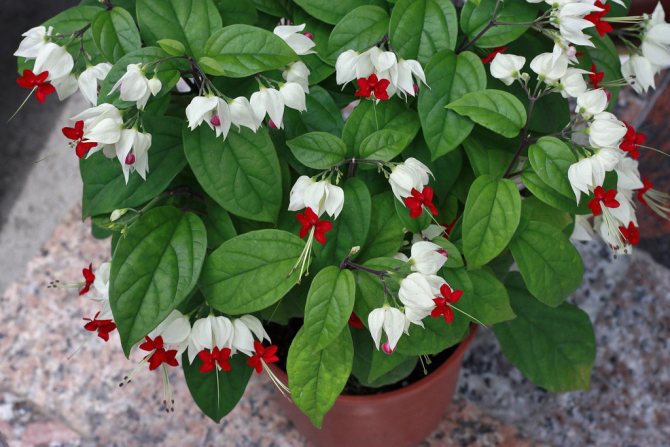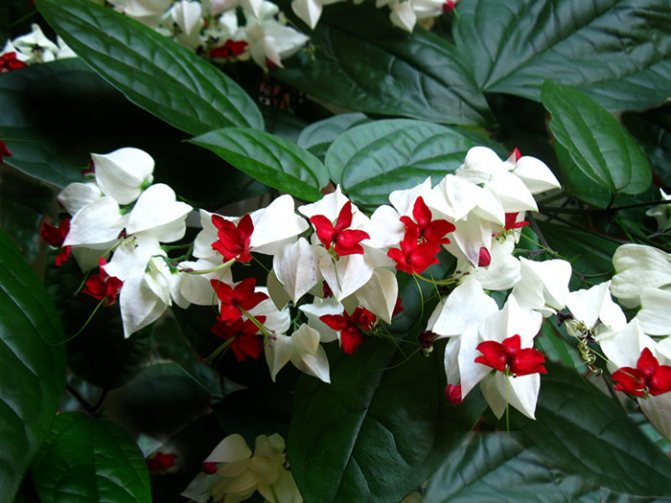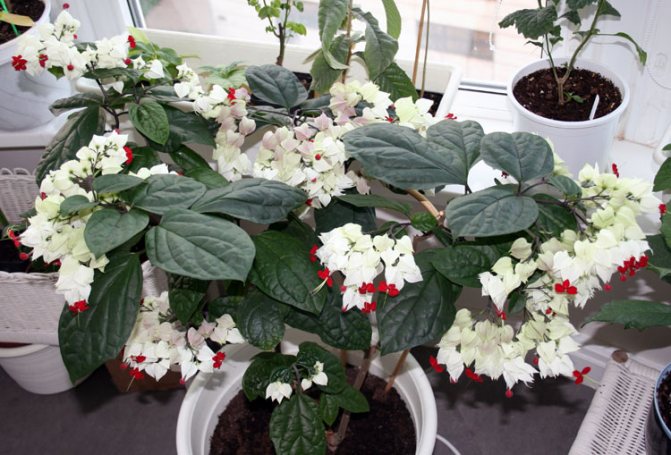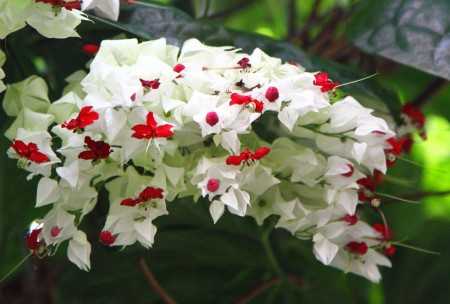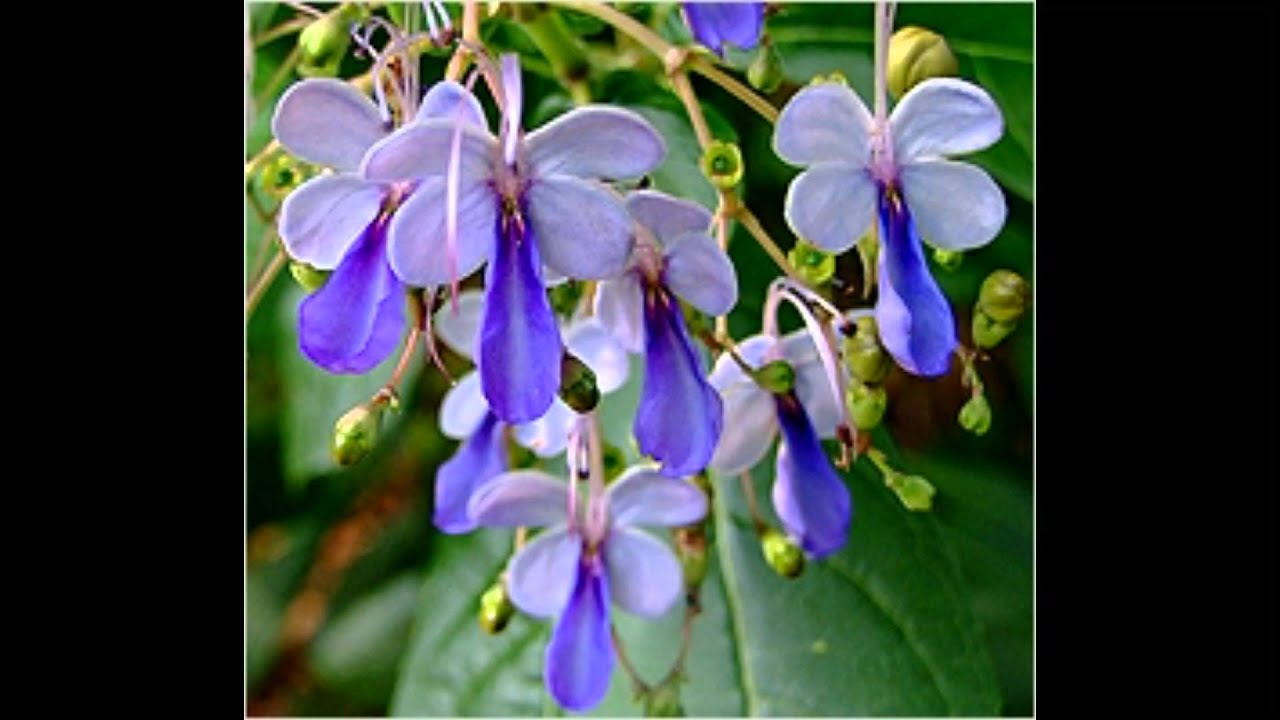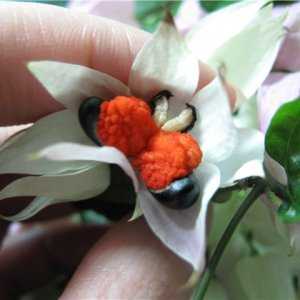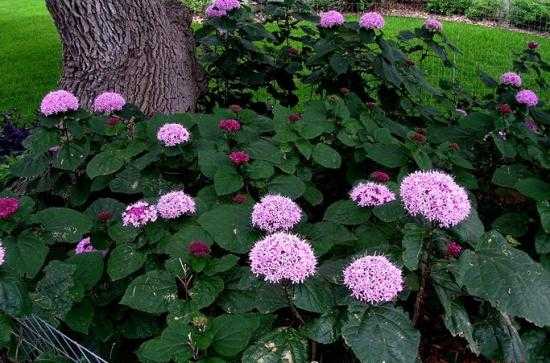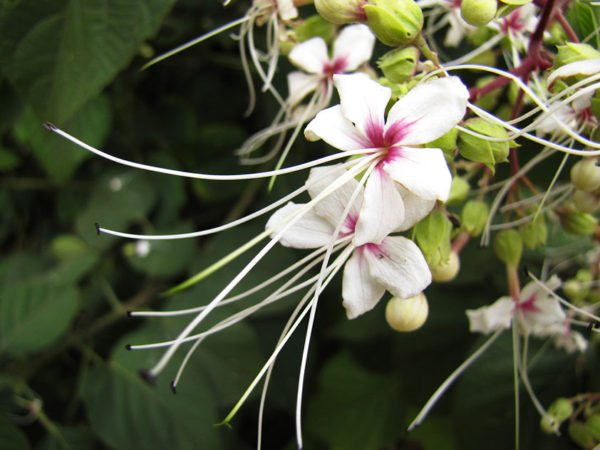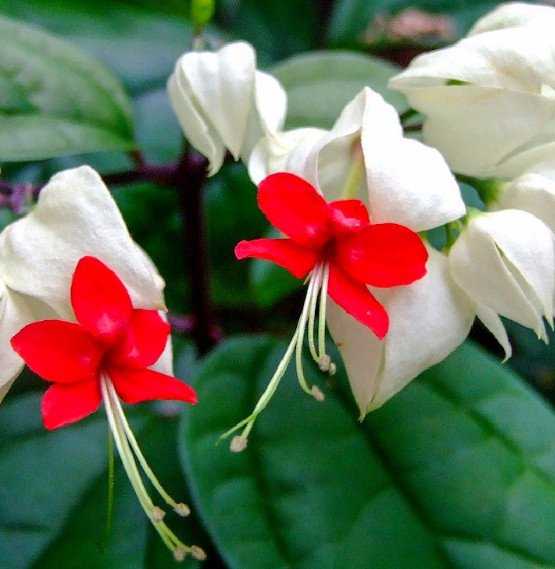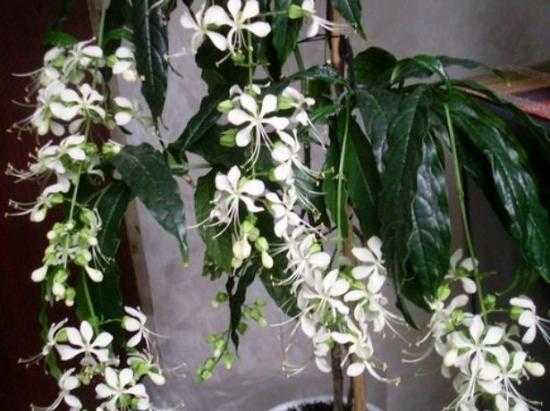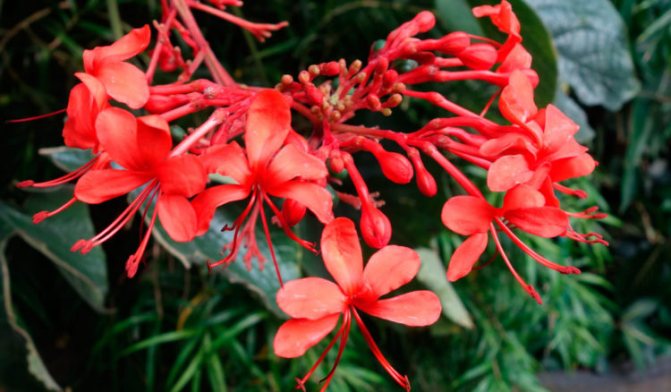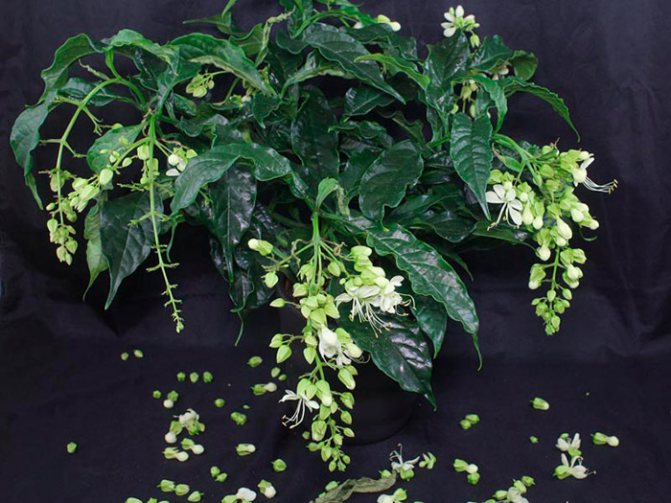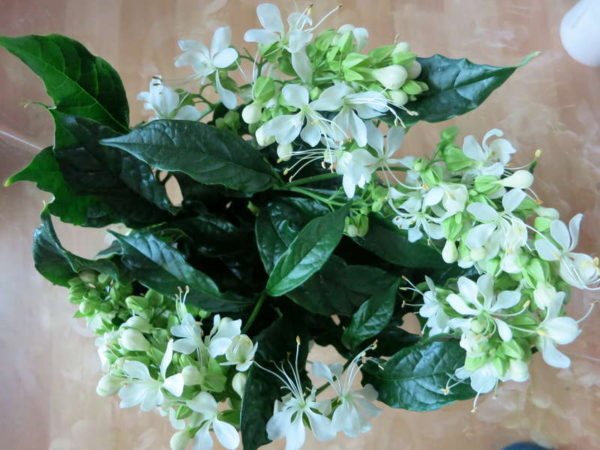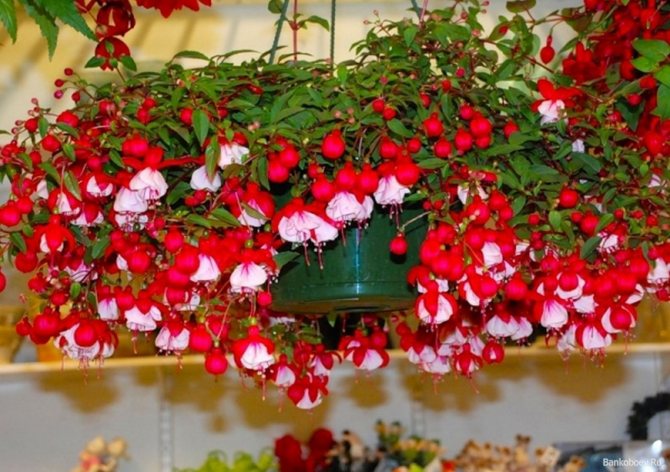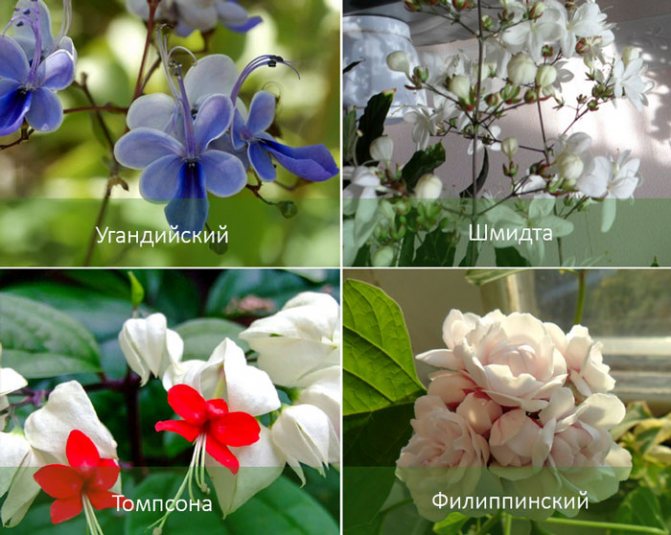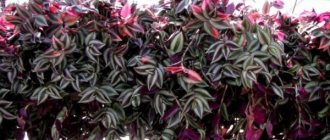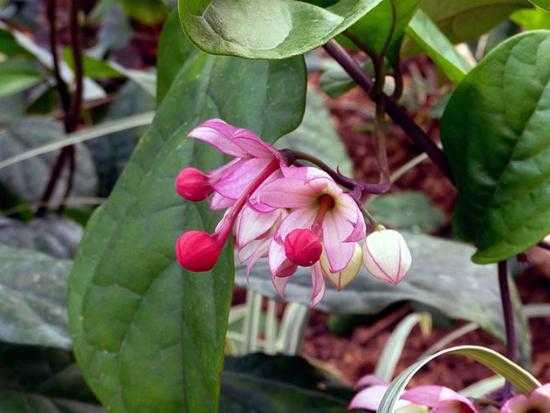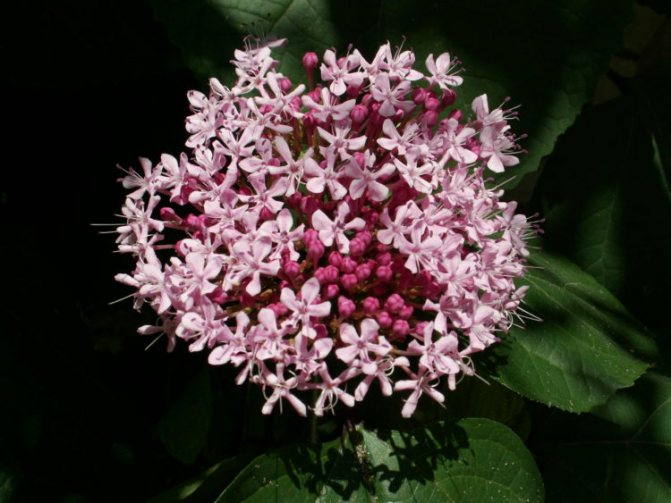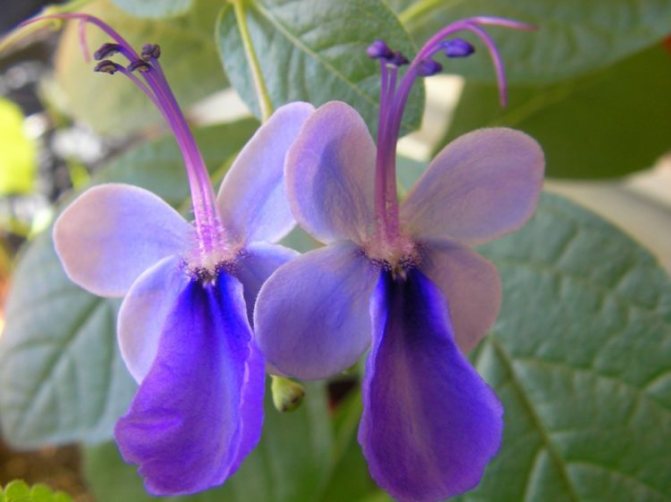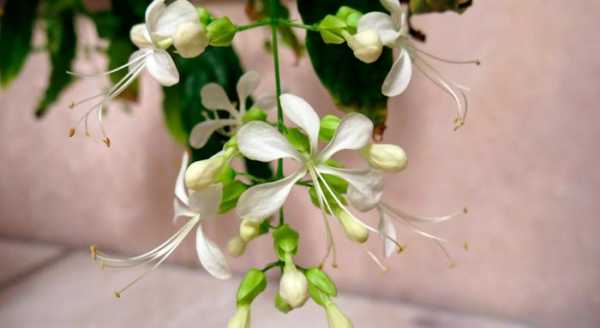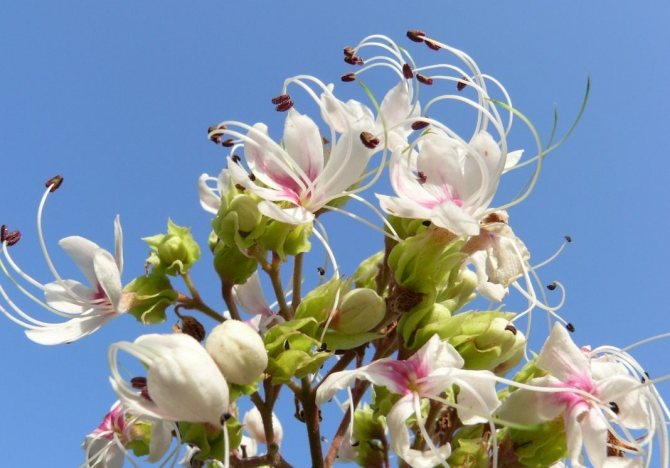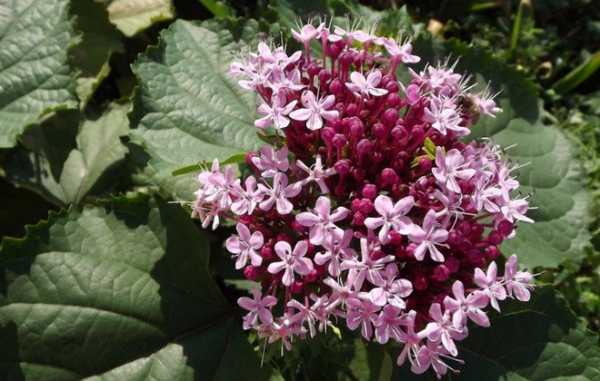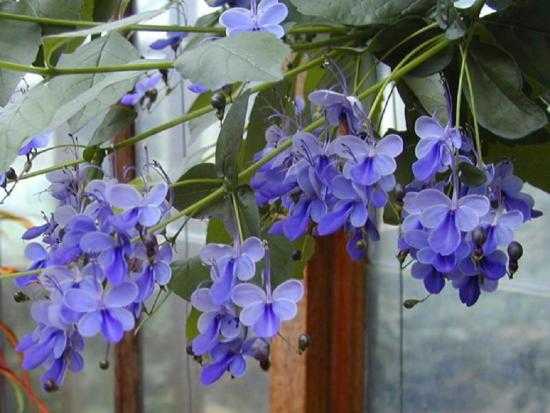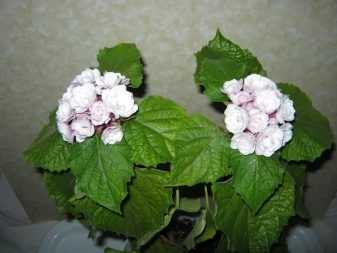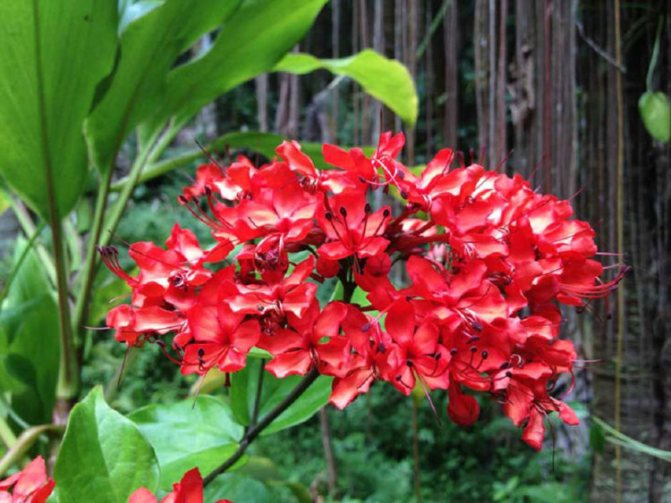Home care
How, where and at what time of year to plant?
As a rule, clerodendrum is sold in the fall, as it blooms profusely at this time of the year and attracts attention. After purchase, the plant cannot be unpacked immediately.
He needs to be given time to adapt to room conditions (1-2 hours).
Important! With inaccurate transportation and sudden changes in temperature, the flowers can be sprinkled.
You need to plant clerodendrum carefully, because its root system is very fragile, in ordinary small pots.
Requirements for soil, pot, habitat and lighting
For planting, it is worth choosing a container no more than 20 cm in diameter, since the flower is miniature. In too much space, the bush will not bloom: the root system will not be able to cope with the excess accumulated moisture.
The primer needs to be breathable and fortified. You can mix it with compost. It will be useful to add commercially available perlite and fine-grained sea sand.
The habitat can be any, the main thing is that the temperature there is not lower than 18 degrees, humid air and good natural lighting. At the same time, the plant does not like direct sunlight.
Requirements for moisture, watering and feeding
This representative of the flora is very picky about feeding. They should be done every two weeks. Suitable for this task:
- Biohumus;
- Lignohumate;
- liquid mullein;
- any complex fertilizers from the store for flowering plants.
The main thing is not to overdo it with organic matter, otherwise all the forces of the plant will go to the leaves, and not to the flowers.
For irrigation, settled water is used. The cooler it is in the room, the less you need to water the clerodendrum.
But it is important to ensure that the soil does not dry out. In the spring-summer period, watering is carried out abundantly, immediately after the topsoil dries out
Advice! The flower needs high humidity, so it should be sprayed with settled water at least once a week. In winter, it should not be kept near heating devices, as they dry the air.
Do you need pruning?
Correct pruning is one of the most important parts of clerodendrum care. Pruning is done with the beginning of growth, in the spring. It is necessary to shorten the shoots by about one third of their length and remove all weak and dried branches. Then give the plant the desired shape. This care method helps it grow and bloom intensively.
How to reproduce?
The plant can be propagated in several ways: by cuttings and seeds.
It is necessary to prepare the cuttings in the spring:
- To do this, divide the lignified twigs into parts with three to four internodes.
- All extra lower leaves are removed, 2-3 upper ones are enough. If they are too large, shorten them by about half to prevent moisture loss.
- Pollinate the lower part of the cuttings with root and plant in prepared pots, on the bottom of which small pebbles should be poured. The soil can be a mixture of sand and peat in equal proportions.
- Put the pots with cuttings in a miniature greenhouse. It needs to be ventilated regularly, and small plants should be sprayed and watered as needed.
- When the roots appear, young clerodendrum need to be accustomed to normal conditions, simply by increasing the airing time. After that, the grown cuttings can be transplanted to a permanent habitat.
Seeds can be harvested from your own plant or purchased from the store.
- Immediately plant them in pots with a mixture of coconut and sand in equal proportions.
- Pots - in a greenhouse and in a warm place.Do not forget to ventilate daily.
- As soon as the sprouts begin to appear, the airing time should be gradually increased.
- Transplant the grown plants to a permanent place.
Types and varieties
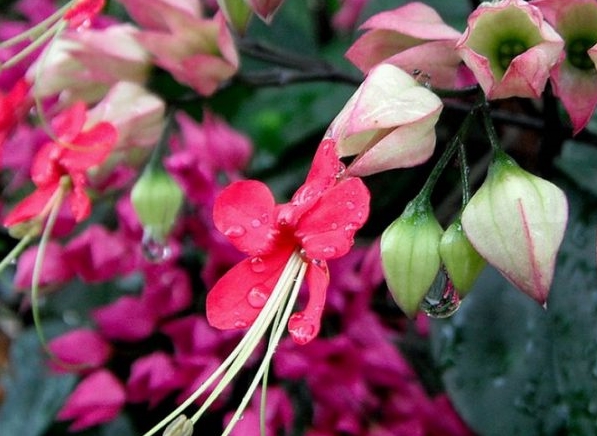
In nature, the evergreen perennial is found in the tropics. It grows in Latin America, Asia and Africa, Australia and the Indian Ocean islands. Liana-like varieties grow up to 4 m in length. Shrub forms in nature reach 2 m. In total, more than 400 varieties of volcameria are known, but only a few are used in home floriculture, which are easy to grow and care for at home.
Clerodendrum Thompson
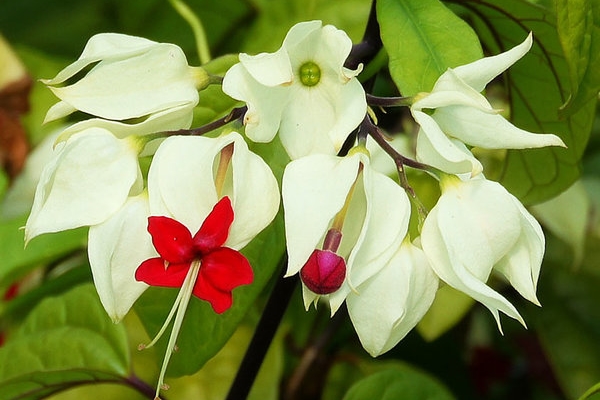
The variety is grown more than others in indoor floriculture. The flower grows like a deciduous vine with a gradually lignified thin stem covered with smooth bark. It has large, dense leaf plates of dark green color. They are covered with noticeable streaks. The shape of the leaves is oblong-ovate with a pointed end. The front side is covered with small spots with irregular outlines of a lighter or darker tone. White buds with a reddish corolla form cluster-like inflorescences. In the apartment, Thompson's clerodendrum grows at a high rate, blooming from March to mid-June. Its reproduction is possible only in a vegetative way.
Clerodendrum brilliant

An evergreen shrub with long, curly stems. Its leaves sit oppositely on the stems or form whorls of 3 pieces. Leaf plates with wavy edges are rounded, reaching a length of 8 cm. Bright red buds on short peduncles form dense clusters sitting in the leaf axils. In a favorable microclimate, this species blooms almost constantly.
Clerodendrum Filipino

Bushes of this species reach a height of 2 m. Their stems are covered with large velvety leaves with serrated edges. Large buds up to 8 cm in diameter are pinkish or creamy. Outwardly, they resemble roses that form thyroid inflorescences. The flowering period of the Philippine Clerodendrum lasts almost all year round.
Clerodendrum Ugandan
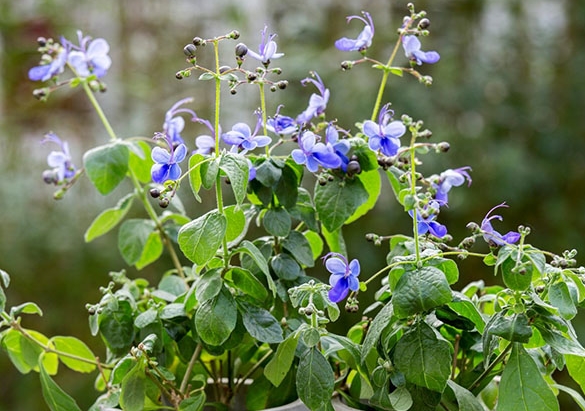
In nature, this evergreen shrub grows to a height of 3 m. It has dark green leaves with a glossy surface. The Ugandan volcameria becomes especially attractive at the stage of flowering. Bright buds appear on it, divided into 5 petals, resembling the shape of butterflies. The largest is colored purple, the rest are blue. The shrub tolerates pruning well.
Clerodendrum Schmidt

Another name for this species is "chains of glory." The plant forms a lush bush. During flowering, it becomes covered with racemose inflorescences reaching a length of 50 cm. Fragrant snow-white flowers hang down in a cascade. The plant blooms twice a year with short interruptions. Under favorable conditions, the buds bloom even in winter.
Fragrant clerodendrum
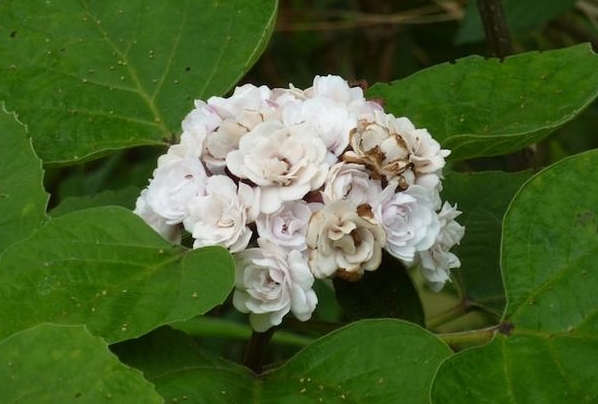
An evergreen shrub that grows up to 2 m in height. Its broad ovoid leaves reach a length of 18 cm. They have a pubescent surface, serrated along the edge. White-pink buds form thyroid inflorescences. During the period of prolonged flowering, they emit a light violet-citrus scent.
Wallich's Clerodendrum

The plant forms a lush bush with large green leaves, wavy at the edges. During flowering, it becomes covered with snow-white buds. They form drooping inflorescences with a delicate aroma. When grown at home, its height does not exceed 50 cm. The flowering of this species begins in August and lasts 2 months.
Clerodendrum beautiful
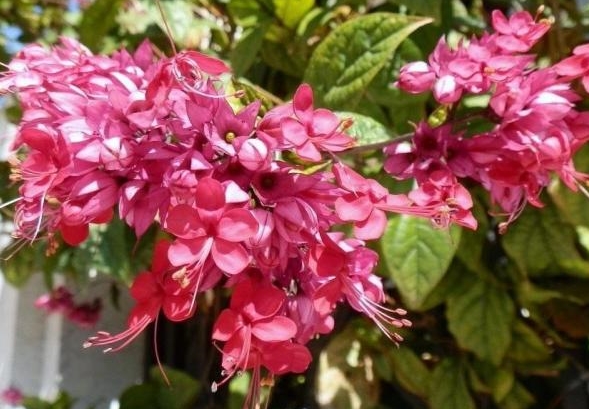
An evergreen shrub grows up to a height of 3 m. The heart-shaped leaf plates are pubescent, sitting opposite on long reddish petioles. Paniculate inflorescences are formed by small flowers with rich red corollas and purple calyxes. Abundant, vibrant bloom begins in June and lasts 4 months.
Clerodendrum Inerme

The plant of the variegated variety has beautiful foliage of a rich emerald hue. A unique look to the bush is given by oval-oblong leaf plates, covered with light marble veins. The deep purple flowers look like graceful butterflies, thanks to the long stamens hanging down. This type is unpretentious, but requires the creation of a special microclimate.
Clerodendrum Bunge
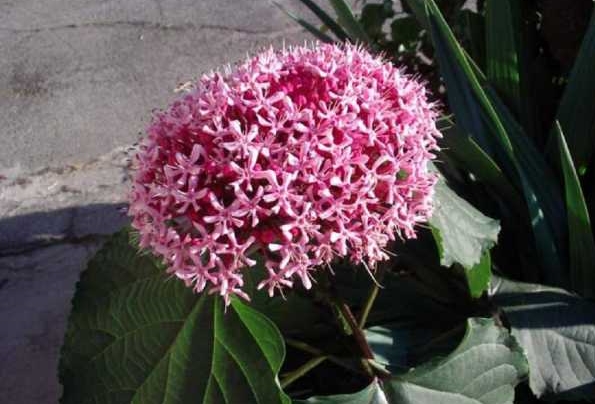
This species was introduced from Southeast Asia. It develops at a high rate. The leaf plates have a wide-oval shape and form whorls. At the ends of the shoots, inflorescences are formed in the form of a ball of small pink buds. From a distance they resemble fireworks. The flowering period lasts from June to August.
Plant transplant
Clerodendrum Thompson, depending on the specific variety, sheds leaves either partially or completely in the cold season. That is why this plant needs to be transplanted into a new pot, as well as warm, in order to gain strength. It should be noted that the container for it should be spacious. It is necessary to transplant a flower into a substrate, which includes peat and greenhouse soil. To do this, take two parts of such a mixture and add coarse sand to it. Then everything is thoroughly mixed and poured into a pot, into which the flower will be transplanted. In addition, good drainage must be placed on the bottom of the container.
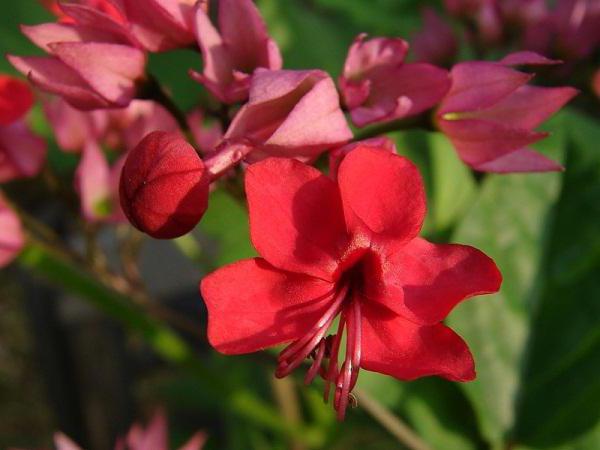
Thompson's clerodendrum, which is easy to prune, can be shaped in different ways. Since this plant is a liana, it easily twists around any support. For example, you can pull on several special threads, but this will mean that in this case it will be impossible to rearrange the flower pot to another place.
Clerodendrum Thompson: home care
Clerodendrum Thompson is one of the few species of the genus Clerodendrum that can take root at home. However, for this to happen, certain conditions must be met.
Correct lighting
Clerodendrum needs a lot of light, direct sunlight will not damage the flower. Therefore, the plant will get along well on the east, south and west sides. However, in the north, it may not have enough light to form buds.

Clerodendrum Thomsoniаe
Watering and feeding mode for flowering
It is necessary to water the plant regularly and abundantly (especially in spring and summer), since clerodendrum loves moisture.
Important! Watering is necessary after the topsoil has dried. Clerodendrum dislikes both drought and the bay
In winter, the plant stops growing and absorbs little water, so during this period it is important to ensure that there is no excess amount of water. You can water with running, settled water at room temperature.
The plant will also do well with regular spraying, especially in summer when it is very hot or if the room is running powerful batteries or heaters. Otherwise, the leaves will turn yellow and the plant will dry out.
In winter (during rest), the vine can simply shed the leaves. If this happens, do not worry and try to increase the humidity. This is a natural process. Although it would be nice to protect the flower from direct hot air.
Note! During the phase of active growth (spring-summer), the plant must be fertilized with liquid fertilizing for flowering indoor plants. This should be done regularly: every week.
In autumn, 1-2 times a month will be enough, in winter this is not necessary at all.
Possible difficulties
Home clerodendrum, albeit unpretentious, still prefers a comfortable microclimate. In the room where inerme is grown, it should be quite warm - from 18 to 25 degrees, and in winter - from 15 to 18. Clerodendrum does not tolerate drafts, so it is better to keep an eye on this.
Although the flower loves warmth, you cannot put a pot near heating pipes and radiators. During the period of winter dormancy, the temperature in the room should be quite cool: no higher than 15 degrees.
In addition to the difficulties with caring for the plant, difficulties may appear in the form of uninvited guests, which will help to get rid of such means as:
- Bona Forte.
- "Aktaroy".
- "Aktellikom".
Clerodendrum instantly conquers the hearts of flower growers with its flowering, so it is difficult to resist the temptation to have such beauty at home. If you give a plant a few minutes a day, then it will delight you with its magical flowering for a long time. And proper care during the dormant period will allow you to enjoy flowering all year round.
Reproduction methods
Clerodendrum propagates equally well by seeds and cuttings. Sowing seeds is usually practiced when there is no way to get a cutting. Shallow boxes with a mixture of sandy-peat soil and turf soil are used. It is better to do this at the end of winter. The container is covered with plastic wrap and left in a warm room with good lighting. Condensation should be removed and the soil sprayed daily. It will take 1.5-2 months before the first shoots appear. When the seedlings grow 4 leaves, a pick is carried out into separate pots. Usually 1-3 plants are placed in a pot with a diameter of 6-11 cm. After adaptation, the seedlings will quickly start growing.
If it was possible to get a clerodendrum stalk with 2-3 nodes, then it is first placed in water with the addition of activated carbon. Cuttings develop best during March-July. With the appearance of small white roots, the plants are moved into small pots. At first, they are covered with a plastic bottle or jar. After adaptation, they are transshipped into larger containers. To get branched bushes, the sprouts should be pinched several times.

What difficulties may arise?
Important. It should again be noted that Wallich's Clerodendrum is a demanding plant to care for.
Often, its cultivation and maintenance cause difficulties for many flower growers.
Errors made during the procedures of feeding, transplanting, pruning and grafting can lead to plant diseases, since the plant's natural defense systems - its immunity - are weakened.
- One of the problems that you can face when caring for a plant is the sudden stop of flowering.
This could be due to:
- lack of fertilizing, fertilizers;
- irregularities of watering, environmental humidity or temperature conditions;
- mistakes in plant transplanting and pruning;
- improper wintering or its absence.
Also, flowering does not occur in plants less than one year old, but this is in the order of things.
- Yellowing of foliage can be caused by a violation of the irrigation and feeding regime of the plant, but it can also be a symptom of chlorosis. In this case, it is necessary to spray the plant with aqueous solutions of the ferum chelate a couple of times a week until the signs of the disease completely disappear.
- The lethargy of the plant and pinpoint damage to the roots by rotting indicate the appearance of root rot in the plant. The plant must be transplanted by removing the affected areas of the root and treated with Bordeaux liquid.
- Often, the bush becomes a victim of pests, including common aphids. Insects occupy the lower part of the leaves, the affected foliage withers and curls. It is necessary to remove the infected foliage and treat the plant with an insecticide. After two weeks, repeat the treatment for the last time.
- The reverse side of the leaves of a plant must be observed especially carefully, because in addition to aphids, other small insects, for example, whiteflies, can appear there. The insects must be removed, and the plant must be treated with Aktara in the same mode as in the case of plant infection with aphids: twice with a break of two weeks.
- Cobwebs and whitish bloom on the back of the leaf may indicate that the plant is infected with a spider mite. The plant is treated with issecticide twice with an interval of two weeks.
- The high humidity required by the plant also becomes a favorable environment for the emergence of various pests and diseases, but with due attention to the bush, infection can be avoided.
Wallich's Clerodendrum is an amazing plant in its beauty and aroma that requires special treatment. Unfortunately, the plant is hardly suitable for novice growers or those who have too busy a schedule and cannot pay enough attention to the bush. But for those who are not afraid of all the difficulties that are encountered when caring for the "nodding jasmine", the plant will delight the eye for a long time.
Main types
In nature, there are more than 300 species of clerodendrum, but not all are suitable for home breeding.
-
Thomson's Clerodendrum. This is the most popular type of clerodendrum among indoor florists. And the point is not only in amazing colors, reminiscent of white hearts gathered in lush bunches with a bright red "drop" hanging from the center. By the time the seeds ripen inside the hearts, they acquire a lilac hue. This climbing liana grows unusually quickly, lengthening the shoots by 2-2.5 meters per season, so it is easy to form. The leaves are also quite beautiful, as if slightly pulled together by internal veins. They can fall off for the winter, and this is completely normal for this deciduous species, which requires a dormant period of several months. Thomson's clerodendrum blooms from early spring to mid-summer, under favorable conditions, repeated autumn flowering is possible.
-
Clerodendrum Ugandan. Another liana-like semi-shrub, but evergreen, which does not need a dormant period. Its blue or purple flowers with long curved stamens are very much like butterflies and consist of two symmetrically located upper, two lateral rounded petals and one lower elongated lower one. Flowering is practically not interrupted, the plant can take only a short pause for the formation of new buds. The most light-loving view, feeling great all year round from the south-facing windows. And the most easily propagating: its cuttings together give roots and take root well.
-
Clerodendrum is the most beautiful. Shrub with evergreen leaves up to three meters high. It has unusual tetrahedral stems, on which large heart-shaped leaves, pubescent with villi, grow in pairs. Small purple flowers with long stamens are gathered in panicles. The plant blooms all summer and part of autumn.
-
Clerodendrum Filipino. Small flowers of this species resemble delicate creamy roses growing in large, rounded 20-centimeter inflorescences. They smell like jasmine, the smell intensifies in the evening and at night. Philippine Clerodendrum is one of the most unpretentious and pest resistant. It is best propagated by layering.
-
Clerodendrum paniculata. The most rare species in our houses and apartments. It is a tree-like plant, the inflorescences of which are similar to panicles or to Buddhist pagodas due to the even tiers of flowers. It grows equally well both in partial shade and in the sun.
-
Clerodendrum Bunge. The only species that can be grown both indoors and in the garden, but with high hilling and winter shelter in regions with not very frosty winters. In the middle lane, it grows as a deciduous coppice shrub up to one meter high, and in the southern regions it is a small tree up to two meters high. Fragrant flowers in rounded inflorescences consist of five pink petals twisted into a tube. At home, the plant blooms almost continuously throughout the year. Propagated by root shoots.
Caring for Clerodendron at home
Clerodendrum Ugandan is considered an unpretentious vine. However, in order to achieve its flowering, a number of the following requirements are fulfilled.
How, where and at what time of year to plant?
When planting the Ugandan Clerodendrum, perform the following actions:
- A layer of expanded clay 2 cm thick is placed on the bottom of a large pot.
- Lay the soil on 2/3 of the container.
- The rhizome is spread in different directions.
- The soil is filled up to the root collar.
Important! Clerodendrum Ugandan is planted in early spring. In summer, this flower is grown at room temperature, equal to 20-25 ° C.
In winter, for normal growth of plants in the house, they maintain such a temperature regime - 12-16 ° C.
Small young plants are moved closer to the window and fenced off from the room with thick curtains. Adults are taken out to the insulated, glazed balcony.
Requirements for soil, pot, habitat, lighting
Clerodendrum Ugandan is planted in slightly acidic soil with a pH of 5-6.5 (humus). When planting plants, they use sod, leaf, humus, peat soil and coarse sand.
Clerodendrum Ugandan is planted in a ceramic flowerpot, which allows air to pass through well and maintains the required amount of moisture. The size of the new pot should be 2 cm larger than the old one - both in width and depth. Young plants are planted in 3-4 pieces in pots with a diameter of 7-11 cm.
A pot of Ugandan Clerodendrum is placed in a well-lit room, where there is little direct sunlight. In the daytime, in the heat, the flower must be shaded.
A pot with such a flower is not placed on the north side of the room, because it does not bloom in this place. If there are no other options, then artificial lighting is installed in the room with various phytolamps or fluorescent lamps.
Requirements for humidity, watering, feeding
Ugandan Clerodendrum is grown in a room with average humidity and above. If the room is too dry, wet expanded clay is added to the pan of the flower pot. The flower is sprayed daily with soft water, in which there are few different salts.
Ugandan Clerodendrum is watered in different ways:
- in summer - abundantly;
- in winter - moderately.
When watering plants, use well-settled, soft and warm water.
Attention! Flower feeding is carried out 1 time in 15 days only from the second half of spring until the end of summer. In such a case, a mineral complex fertilizer is used for flowering home flowers.
Do you need pruning, pinching?
Clerodendrum Ugandan must be cut off. Pruning is carried out before the beginning of the growth of the vines (in spring) or after the end of flowering (in the fall). In this case, the shoots are cut to half or 1/3 of their length.
When pruning, a clerodendrum is formed in the form of a liana and a standard tree. The shoots that grow on the trunk below the crown are cut off in time.
How to propagate a plant with blue flowers?
Clerodendrum Ugandan is propagated in 2 ways - by seeds and cuttings. However, cuttings are more often carried out.
When grafting Ugandan Clerodendrum, perform the following actions:
- At the beginning of spring, an 8-10 cm stalk with 2-3 leaves is cut from the upper part of the shoot.
- 1/3 of the cuttings are dipped into such a solution = biostimulator "Epin" + "Kornevin" + biological preparation "Topaz" + potassium humate.
- Cover the stalk with a plastic glass.
- After 1 day, the cuttings are rooted - sand and peat (or humus) are added to a pot with a diameter of 7-9 cm in equal proportions.
Important! The first 3-4 days the flower is not watered. Supports are installed next to the vine.
After 4-5 months. Clerodendrum Ugandan is transplanted into the soil for adult plants and the shoots are pinched by 1/4.
At a temperature of 23-25 ° C, the roots grow in about 1.5-2 months. After that, the seedlings are placed in separate cups. Then, to form the crown, Ugandan Clerodendrum is periodically pinched.
How to form a bush?
Ugandan Clerodendrum is grown in the form of a small bush, as well as in ampelous or standard form. To obtain a shrub in early spring, 3 strong lignified shoots are left, and the rest are cut out.
The remaining shoots are cut by 1/3. After the appearance of green twigs, pinch their tops. When forming a lush bush, root shoots are not cut out.

